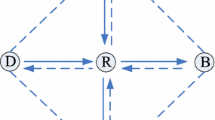Abstract
Energy is a scarce resource in wireless networks. Network coding has been proposed recently as a means to reduce the number of transmissions and energy consumption. In this paper, we introduce timing control into network coding to further enhance its performance. It is found that when bandwidth is sufficient, the extra delay introduced by waiting for additional data to perform network coding will increase the number of codings without affecting system throughput. Both delay and throughput suffers when bandwidth is insufficient. An adaptive energy-efficient timing control algorithm called AEETC is proposed which can automatically adjust local node’s transmission behavior on the basis of the network traffic conditions. Simulation results demonstrate that AEETC increases network coding by 7% to 60% for light network load and is able to provide good performance in terms of delay, throughput and the number of successful codings.
Similar content being viewed by others
References
Ahlswede, R., Cai, N., Li, S. R., & Yeung, R. W. (2000). Network information flow. IEEE Transactions on Information Theory, 46(4), 1204–1216.
Chaporkar, P., & Proutiere, A. (2007). Adaptive network coding and scheduling for maximizing throughput in wireless networks. In Proc. of ACM MOBICOM 2007.
Fragouli, C., Boudec, J. L., & Widmer, J. (2006). Network coding: an instant primer. ACM SIGCOMM Computer Communication Review, 36(1), 63–68.
Hu, F., May, C., & Cao, X. (2006). Data aggregation in distributed sensor networks: towards an adaptive timing control. In Proc. ITNG’06.
Katti, S., Rahul, H., Hu, W., Katabi, D., Medard, M., & Crowcroft, J. (2006). XORs in the air: practical wireless network coding. In Proc. ACM SIGCOMM 2006.
Li, S.-Y. R., Yeung, R. W., & Cai, N. (2003). Linear network coding. IEEE Transactions on Information Theory, 49(2), 371–381.
Sagduyu, Y. E., & Ephremides, A. (2005). Joint scheduling and wireless network coding. In Proc. of Netcod 2005, April 2005.
Sagduyu, Y. E., & Ephremides, A. (2005). Crosslayer design for distributed MAC and network coding in wireless Ad Hoc networks. In Proc. of ISIT 2005.
Sengupta, S., Rayanchu, S., & Banerjee, S. (2007). An analysis of wireless network coding for unicast sessions: the case for coding-aware routing. In Proc. IEEE INFOCOM, May 2007.
Wang, D., Zhang, Q., & Liu, J. (2006). Partial network coding: theory and application in continuous sensor data collection. In Proc. of IWQoS 2006, June 2006.
Zhu, Y., Li, B., & Guo, J. (2003). Multicast with network coding in application-layer overlay networks. IEEE Journal on Selected Areas in Communications, 22(2), 107–120.
Zhu, J., Papavassiliou, S., Kafetzoglou, S., & Yang, J. (2006). An efficient QoS-constrained data aggregation and processing approach in distributed wireless sensor networks. In Proc. of the 11th IEEE symposium on computers and communications (ISCC’06).
Author information
Authors and Affiliations
Corresponding author
Additional information
The main part of this paper is completed at City University of Hong Kong.
Rights and permissions
About this article
Cite this article
Li, H., Chan, E. & Chen, G. AEETC—adaptive energy-efficient timing control in wireless networks with network coding. Telecommun Syst 45, 289–301 (2010). https://doi.org/10.1007/s11235-009-9272-8
Published:
Issue Date:
DOI: https://doi.org/10.1007/s11235-009-9272-8




